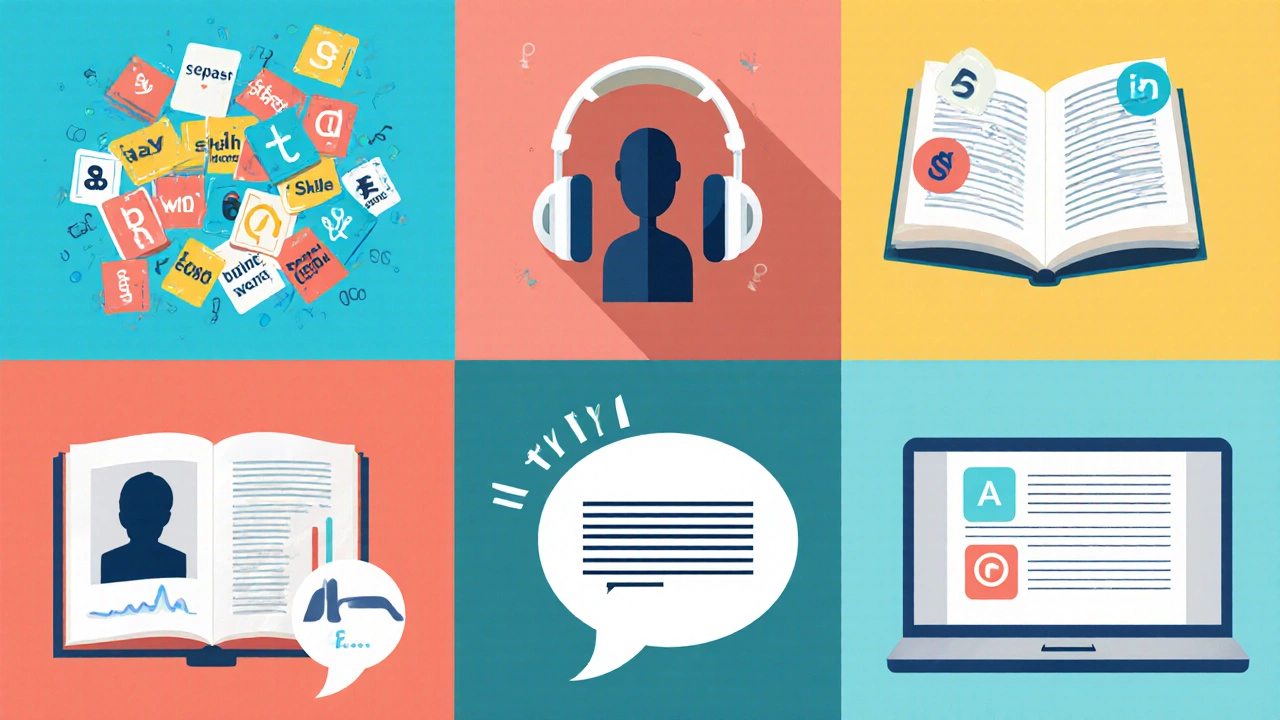Self-Study Guide: How to Learn English by Yourself
 Oct, 15 2025
Oct, 15 2025
English Learning Goal Tracker
Set Your Learning Goals
Your Personalized Plan
Goal
Total Time
Daily Focus
Weekly Milestones
Tip for Your Focus
When you decide to learn English alone, you’re betting on a journey that can fit into any schedule, budget, or learning style. The English language is a global lingua‑franca that opens doors to education, work, and travel. Yet many wonder how to make progress without a classroom or a teacher. Below you’ll find a step‑by‑step roadmap that turns curiosity into fluency, plus real‑world tools you can start using today.
Key Takeaways
- Set specific, time‑bound goals to keep motivation high.
- Focus on six skill pillars: vocabulary, grammar, listening, speaking, reading, and writing.
- Use free or low‑cost resources like apps, podcasts, and YouTube channels.
- Build a daily habit of 20‑30 minutes and track progress with simple metrics.
- Avoid common pitfalls such as passive consumption and perfectionism.
Why Self‑Study Can Beat Traditional Classes
Self‑study lets you customize pace, topics, and materials. You can jump from beginner basics to a business‑level podcast in weeks, not months. Plus, you save on tuition, commute, and rigid timetables. The trade‑off? You need a clear plan and the discipline to stick with it.
1. Set Clear, Measurable Goals
Goal‑setting is the backbone of any successful language journey. Instead of vague aims like “be better at English,” break it down:
- Choose a proficiency benchmark - e.g., CEFR B1 within three months.
- Identify the skill that matters most for you - speaking for job interviews, reading for academic papers, etc.
- Define weekly milestones - learn 150 new words, finish one grammar chapter, watch a 10‑minute video without subtitles.
Write these targets in a notebook or a digital planner and revisit them every Sunday.
2. Build the Six Core Skill Pillars
Each pillar reinforces the others. Treat them as a balanced diet; neglecting one leads to plateaus.
Vocabulary
Start with high‑frequency words. The Oxford 3000 list covers 95% of everyday conversation. Use spaced‑repetition apps (like Anki) to review cards daily. Add context: write a sentence, say it aloud, and associate an image.
Grammar
Grammar gives structure to your thoughts. Focus on one rule at a time - present simple, then move to past perfect. Websites such as British Council offer concise explanations plus interactive quizzes. After each rule, create three original sentences to cement usage.
Listening
Listening trains your brain to recognize natural rhythm and pronunciation. Begin with slow‑speed podcasts for learners, then graduate to native‑speed news (BBC Radio 4) or TED Talks. Transcribe short segments (30‑seconds) and compare with subtitles to spot gaps.
Speaking
Speaking is the toughest skill to practice alone, but you can create speaking loops:
- Shadow native speakers: repeat a sentence immediately after hearing it.
- Record yourself answering common prompts (e.g., “Describe your last vacation”).
- Join language‑exchange apps like Tandem for brief 5‑minute voice chats.
Focus on fluency first; worry about perfect grammar later.
Reading
Reading expands vocabulary and shows grammar in context. Start with graded readers (level A2‑B1) and then move to news websites (The Guardian, VOA). Use the “three‑pass” method: skim for gist, read for details, then summarize in your own words.
Writing
Writing consolidates everything you’ve learned. Keep a daily journal of 100‑150 words. Occasionally write longer pieces - an email, a review, or a short story - and run them through Grammarly or the free Hemingway editor for feedback.

3. Choose the Right Tools for Self‑Study
Resources can be overwhelming. Below is a quick comparison to help you pick a mix that suits your learning style and budget.
| Resource | Cost | Best for | Primary Skill Focus |
|---|---|---|---|
| Duolingo (app) | Free / $6.99/mo premium | Beginners, quick daily practice | Vocabulary & Grammar |
| BBC Learning English (podcast) | Free | Intermediate listeners | Listening & Pronunciation |
| English with Lucy (YouTube) | Free | Visual learners | Grammar, Speaking Tips |
| Project Gutenberg (e‑books) | Free | Avid readers | Reading & Vocabulary |
Mix at least one tool from each column. For example, use Duolingo for daily vocab drills, listen to BBC podcasts during commute, watch Lucy’s videos for grammar hacks, and read a short story from Project Gutenberg before bed.
4. Build a Sustainable Daily Habit
Consistency beats intensity. Aim for 20‑30 minutes a day, split into micro‑sessions if needed:
- 5min: flashcard review.
- 5min: quick grammar quiz.
- 10min: listen to a podcast segment.
- 5‑10min: write a short paragraph or record a speaking prompt.
Use a habit‑stacking technique: pair English study with an existing routine (e.g., brew coffee, then open your app).
5. Track Progress and Adjust Your Plan
Numbers keep you honest. Track three metrics weekly:
- Word count added (via your flashcard app).
- Hours of listening completed (most podcast apps display this).
- Number of speaking recordings uploaded (set a target of 3 per week).
If you notice a drop, tweak the mix - perhaps swap a podcast for a short video or add a new grammar workbook.

6. Common Pitfalls and How to Dodge Them
Even disciplined learners slip. Recognize these traps early:
- Passive consumption: Watching movies with subtitles only reinforces reading, not speaking. Pause, repeat lines aloud, then turn off subtitles.
- Perfection paralysis: Waiting for “perfect” grammar stalls conversation. Embrace mistakes; each error is data for improvement.
- Resource overload: Jumping between too many apps leads to shallow learning. Stick to 3‑4 core tools for at least a month before evaluating alternatives.
7. Take the First Step Today
Pick one tiny action right now: download a free vocab app, subscribe to a beginner podcast, or open a short article on a news site. Set a timer for 10minutes and just start. The momentum you create in the first hour often determines whether the habit sticks.
Frequently Asked Questions
How long does it take to become conversational in English?
For most motivated self‑learners, reaching a solid conversational level (CEFR B1‑B2) takes 6‑12months with consistent 20‑30minute daily practice. Speed varies based on prior language experience and how actively you practice speaking.
Can I learn English without ever meeting a native speaker?
Yes, but you’ll miss out on natural pronunciation nuances. Use language‑exchange apps, shadow videos, and speech‑recognition tools to simulate interaction. Even occasional 5‑minute voice chats make a big difference.
What’s the best free resource for improving listening?
BBC Learning English’s “6‑Minute English” podcast offers short, clear episodes with transcripts. It balances speed and vocabulary for intermediate learners and is completely free.
How can I remember new words longer?
Use spaced‑repetition flashcards, but also see the word in three contexts: a sentence you write, a spoken example you record, and a real article you read. The more connections, the stronger the memory.
Is grammar study necessary for speaking fluently?
Grammar gives you a toolbox, but fluency comes from using language in real situations. Study grammar enough to form correct sentences, then shift focus to speaking practice.